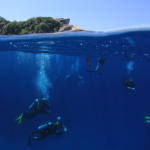Scientists Stumble Upon Real-Life SpongeBob and Patrick Lookalikes in the Deep Ocean

It isn’t every day that the Earth rewrites its own story. Yet this summer, in the remote wilds of Alaska, a brand-new island appeared where no one expected one. A mountain that for centuries had been bound within the frozen grip of the Alsek Glacier now stands apart, completely surrounded by water. The sight is at once beautiful and disquieting, a reminder that even landscapes we think of as timeless can transform within the span of a single human life. It challenges us to rethink what permanence really means in a world where ice is melting and boundaries are shifting before our eyes.
NASA has confirmed that this dramatic separation took place between July 13 and August 6, 2025. In that short window, the glacier retreated enough to sever Prow Knob, leaving it encircled by Alsek Lake and reborn as Alaska’s newest island. What looks like a natural marvel is also a warning. The transformation is a symptom of a larger pattern: glaciers are vanishing, waters are rising, and Earth’s maps are being quietly redrawn. The question is not whether change is happening, but how we will respond to the truths the planet is presenting in plain sight.
*laugh* I normally avoid these refs..but WOW. REAL LIFE Sponge bob and Patrick! #Okeanos Retreiver seamount 1885 m pic.twitter.com/fffKNKMFjP
— Christopher Mah, @echinoblog.bsky.social (@echinoblog) July 27, 2021
From glacier to island: how Prow Knob broke free
Prow Knob has long been part of the Alsek Glacier system, a mountain held firm in the icy embrace of southeastern Alaska’s frozen landscape. For generations, it seemed inseparable from the glacier that pressed against its flanks, one body locked into another. But glaciers, as immovable as they appear, are never truly static. As the climate has warmed, ice has thinned year by year, and meltwater has quietly gathered in small pools that widened into lakes. These proglacial lakes crept further into the glacier, eating away at its foundations until the ties binding Prow Knob began to fray.
Over decades, the story unfolded slowly, almost invisibly, as the ice retreated in increments that only satellites and careful measurements could trace. Yet the pace of change quickened in recent years, and by the summer of 2025 the connection was ready to break. NASA’s satellite data revealed the moment when water finally cut fully around the mountain, completing the process. What had always been part of the glacier’s body was now set apart, transformed into a solitary island in the swelling waters of Alsek Lake. The shift felt sudden, but it had been a century in the making.
This is why scientists describe such transformations as thresholds. A glacier may appear solid, but once enough ice is lost, the collapse of stability can come abruptly. Prow Knob’s separation was the final stage in a long retreat, the moment when decades of invisible change manifested in a clear and undeniable way. To stand on the edge of Alsek Lake now is to witness a place that has been remade in the span of a few decades, proof that even the most enduring landscapes are susceptible to change.
Why NASA is sounding the alarm
For NASA and other scientific institutions, the creation of a new island is not merely a geographical footnote. It is a warning sign that Alsek Glacier has lost one of its stabilizing anchors, leaving it far more vulnerable to collapse. Glaciers rely on pressure and contact to hold their shape. Without the support of Prow Knob, the ice is freer to calve into the lake, breaking apart into large blocks that melt faster in open water. The process feeds on itself, accelerating retreat in ways that make recovery nearly impossible.
Data collected over decades shows just how dramatic this retreat has been. In the 1980s, Alsek Lake measured around 45 square kilometers. Today, it sprawls over 75 square kilometers, nearly doubling in size as the glacier has pulled back. Each expansion reflects another layer of ice loss, another step in the destabilization of a once-mighty system. What makes this alarming is not only the scale of the loss, but the speed. Glaciers that once took centuries to shrink are now receding within decades, reshaping landscapes faster than ecosystems — or human communities — can adapt.
This pattern is part of what scientists call a feedback loop. Ice reflects sunlight, keeping the surface cool, while dark water absorbs heat and warms the surrounding environment. As more ice disappears, more water is exposed, accelerating the melting process further. This is why NASA emphasizes events like Prow Knob’s separation as pivotal. They are not curiosities confined to a single glacier in Alaska. They are indicators of a global system tipping toward instability, one that could have profound consequences for coastlines, weather patterns, and sea levels around the world.

Photo Credit: Ocean Explorer
What it signals: more than a novel landform
The sudden appearance of a new island is a striking image, but it is not an isolated event. All across the planet, glaciers are retreating in ways that create new lakes, expose hidden valleys, and reshape entire regions. In Greenland, vast ice sheets are calving into the ocean at unprecedented rates, raising global sea levels. In the Himalayas, glacial lakes are swelling so quickly that they pose new risks of catastrophic floods for the communities living downstream. In the Andes, the slow disappearance of glaciers threatens water supplies that millions rely on for drinking, farming, and hydropower.
What happened at Prow Knob is therefore part of a much larger narrative. It reminds us that climate change is not always gradual and predictable. For years, the Alsek Glacier receded by increments, but once enough ice had vanished, the collapse came quickly. A threshold was crossed, and what had seemed stable was suddenly gone. This pattern is mirrored in ecosystems across the globe, where slow change builds up until it breaks suddenly, leaving us to grapple with transformations that seem abrupt but have been in motion for decades.
To dismiss Alaska’s new island as a quirk of geography is to miss its deeper meaning. It is a visible marker of the profound shifts underway in Earth’s systems, a symbol of how fragile “permanence” truly is. Glaciers that once seemed eternal are receding within a single generation. Landscapes are remaking themselves on timelines that match our lifespans, not geological epochs. The question is not whether more islands, lakes, and reshaped coastlines will appear, but how prepared we will be to confront the reality they represent.

A personal moment: facing our smallness and power
The story of Prow Knob is humbling. It shows us that forces far larger than ourselves are at work, capable of moving mountains and rewriting maps. It is easy, when confronted with such vast processes, to feel small and powerless, like a fleeting presence in a drama that spans millennia. But humility should not lead to despair. For as much as glaciers and mountains feel beyond our reach, the forces driving their retreat are intimately connected to human activity. The energy we use, the policies we shape, the industries we support — all ripple outward until they touch even the most remote landscapes on Earth.
This realization can be overwhelming, but it also opens the door to empowerment. If human choices have been powerful enough to destabilize glaciers, then they can also be powerful enough to slow their retreat. While one person’s choices may seem insignificant on their own, they are threads that, when woven together with millions of others, form the fabric of change. Whether through supporting renewable energy, pressing for responsible climate policy, or simply sharing knowledge that counters misinformation, each step contributes to a momentum that is desperately needed.
The birth of a new island is, then, both a warning and an invitation. It warns us of what is being lost: ice that will not return, stability that cannot be reclaimed. But it also invites us to see clearly, to confront what is happening, and to act while we still can. The transformation of Prow Knob can be a symbol not just of retreat, but of awakening — a reminder that the choices we make matter, and that it is still within our power to shape the kind of world future generations will inherit.
The island as a mirror
Alaska’s newest island is more than a geographical novelty. It is a mirror held up to our age, reflecting back the truth that change is already here and accelerating. The creation of this island captures both the beauty and the peril of Earth’s transformations — a reminder that the natural world is dynamic, yet also deeply vulnerable to the pressures we place upon it.
When you picture Prow Knob standing solitary in the waters of Alsek Lake, let it remind you that nothing, not even mountains, is immune to change. The permanence we trust is often more fragile than we want to admit. What matters now is how we respond to these signals. We can choose to see them as curiosities and move on, or we can recognize them as messages that demand reflection and action. The island stands not only as a piece of land, but as a symbol of responsibility. In its story is our story — one of choices, consequences, and the possibility of renewal if we dare to act before the maps of tomorrow are written without us.
Loading...

